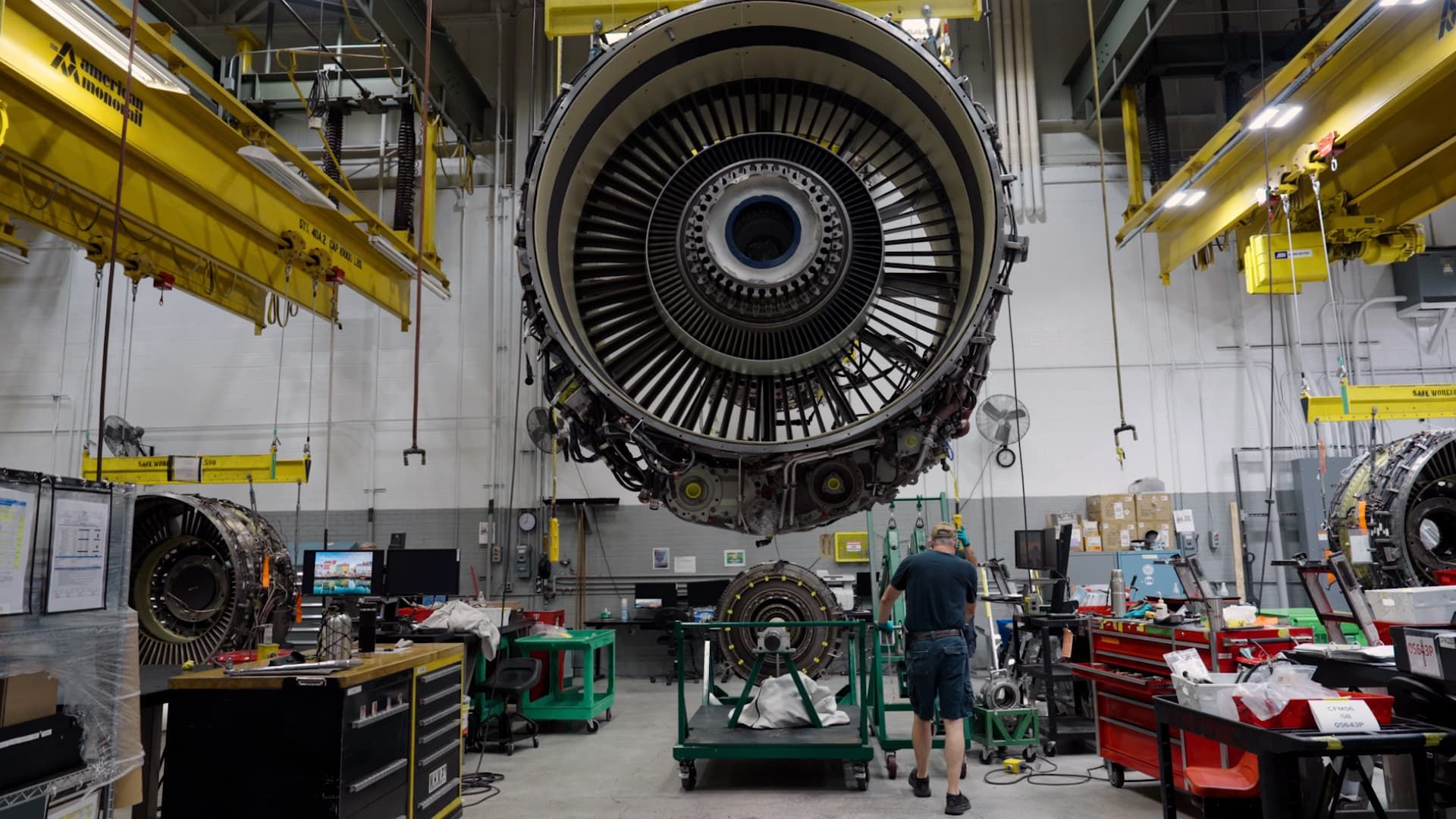TULSA, Okla. — Parts and labor shortages. Delayed deliveries of new planes Boeing and Airbus. An engine recall. Premature repairs. It's all piling up and aircraft engine workshops around the world are overwhelmed.
As travelers boarded planes in record numbers this summer, airline executives anxiously awaited engine repairs and overhauls.
Engine repair and overhaul has grown from a $31 billion business before the pandemic to $58 billion this year, according to Alton Aviation Consultancy. It's a goldmine for engine makers like GE Aerospace and the hundreds of smaller specialists that service GE and other engines made by Pratt and Whitney and Rolls-Royce.
American Airlines'The solution is to do more work yourself.
“We have one customer, American Airlines, that does our job,” said American's chief operating officer, David Seymour. “We can control our own destiny in that area.”
American Airlines workers perform maintenance on the CFM-56 engine in Tulsa, Oklahoma
Erin Black | CNBC
At its bustling engine shop at the airline’s 3.3 million-square-foot maintenance facility at Tulsa International Airport — the largest such space in the world — American is on track to increase its overhauls by about 60% starting in 2023 to more than 16 engines a month this year. That’s up from five a month in 2022. It has added about 200 jobs there, as well as more equipment like cranes to suspend the 2-ton engines during overhauls.
The work centers on CFM56 engines, made by a joint venture between GE and France’s Safran. These engines power American’s older Boeing 737 jetliners and many Airbus A320s. The narrow-body planes make up the majority of American’s mainline fleet of more than 960 planes, according to an annual company filing with regulators.
“I can get these engines overhauled and back to the shop in less than 60 days, compared to… [outside] stores today [are] “120 to 150 days, in some cases over 200 days,” said COO Seymour.
Bottlenecks abound
American Airlines workers check an engine in a hangar in Tulsa, Oklahoma.
Leslie Josephs/CNBC
Much of the bottleneck in engine repairs stems from the industry’s rocky exit from the pandemic, when companies laid off thousands of skilled workers. Airlines that delayed maintenance during the travel slump rushed to get planes airworthy when demand rebounded, but faced shortages of workers and key items from engine components to airplane seats.
Meanwhile, Airbus and Boeing are behind on deliveries of new, more fuel-efficient planes, forcing airlines including American to keep their older aircraft for longer than planned.
This summer, Airbus cut its aircraft delivery forecast and announced cost cuts as it grapples with supply chain problems and delays in landing gear and engine deliveries.
“I would also call it the surprise factor for 2024,” Airbus Chief Financial Officer Thomas Toepfer said on an earnings call on July 30.
In addition to supply chain issues, Boeing planes have been delayed as the company grapples with a safety crisis after a door panel on one of its 737 Max planes exploded in mid-air earlier this year.
With many engines requiring an overhaul every 7,000 flights or so, keeping older planes around longer means more routine maintenance and refurbishments, which increases demand when they do come into the shop. Those multiweek overhauls are exhaustive — they can cost $5 million each and can cost twice that for wide-body jets, according to Kevin Michaels, chief executive of AeroDynamic Advisory.
At American's Tulsa shop, workers remove hundreds of parts, replace life-limited components and clean and inspect others, including spraying them with a fluorescent penetrant so defects can be seen under a black light.
An American Airlines worker sprays fluorescent penetrant on engine components to check for defects in a hangar in Tulsa, Oklahoma.
Leslie Josephs/CNBC
But key parts are hard to find and must be in perfect condition. They are also expensive. Dozens of engine compressor blades can cost $30,000 each.
On top of that, some newer engines, which run cooler, consume more air and burn less fuel than older types, are arriving in shops earlier than expected, frustrating airline chief executives.
“There is no business that can stomach not using key assets to generate revenue,” said AirBaltic CEO Martin Gauss.
The Riga, Latvia-based airline, a customer of the Airbus A220, has had to lease aircraft in recent years to compensate for the lack of grounded planes.
“Unfortunately, passengers are not happy when they can't fly on new planes,” he said. “It's a problem that will be solved one day. We thought it would have been solved by now. I'd give it another two years and then we'd sort it out.”
There is another problem clogging up engine shops: the retirement of some of Pratt & Whitney's narrow-body engines. In light of the current problems, some low-cost airlines, including JetBlue Airlines and Spirit Airlinesare postponing deliveries of new aircraft in an attempt to save money.
“It's a perverse mix that has had a significant impact on the engine supply chain,” said Michaels of AeroDynamic Advisory.
A windfall for engine manufacturers
An American Airlines worker looks inside an engine at a maintenance shop in Tulsa, Oklahoma.
Erin Black | CNBC
High demand for engine overhauls has been lucrative for engine suppliers, who make billions from servicing the engines they sell with new aircraft.
GE Aerospace reported $11.7 billion in engine maintenance, repairs and overhauls in the first half of 2024, accounting for 65% of its revenue.
“When it comes to motors, the razor blade business is very complicated,” Michaels said, describing how buying razors at a drugstore can mean buying replacement blades for years. “So the money is made in the aftermarket of the motor business.”
GE Aerospace, which became an independent company in April, said in July it will invest $1 billion to modernize its engine shops around the world over the next five years.
Do you have spare parts?
For many airlines, there are few alternatives to costly engine overhauls as demand for replacement engines is on the rise, especially if the airline has an aircraft type or model that only has one supplier.
An aircraft engine at the American Airlines test facility in Tulsa, Oklahoma.
Leslie Josephs/CNBC
Lease prices for engines that fit both new and older aircraft have skyrocketed. For example, a CFM56 engine used on the Boeing 737-800 cost $96,000 a month, up from $78,000 in 2017, according to aviation data firm IBA.
Meanwhile, the Pratt & Whitney and CFM engines powering the new Airbus A320neo aircraft have seen lease rates of $127,000 per month, up from $80,000 and $85,000 respectively in 2017, IBA said.
Leasing companies such as AerCap and Avolon have been buying up replacement engines due to high demand.
However, it is still difficult to get into an engine shop.
Delta Air LinesLike American, it overhauls, repairs and maintains its own engines. It also does work for other airlines, but its chief executive, Ed Bastian, says the shop is full.
“If you don't have a contract in place, you can't get in,” she said in an interview in July. “It would be easier to get into a Taylor Swift concert.”









